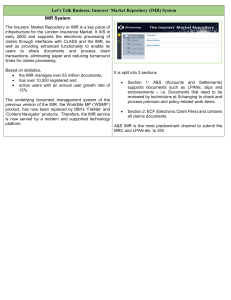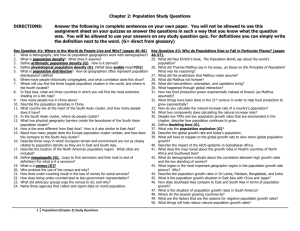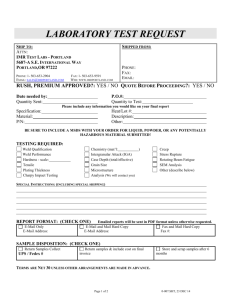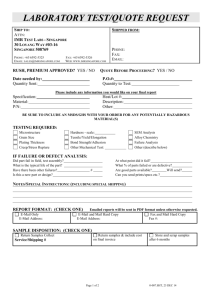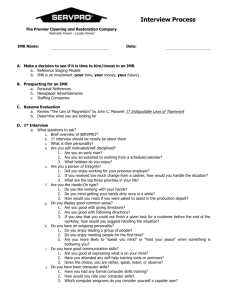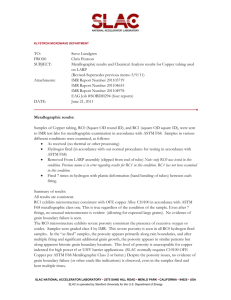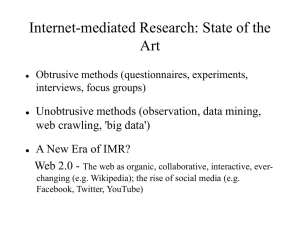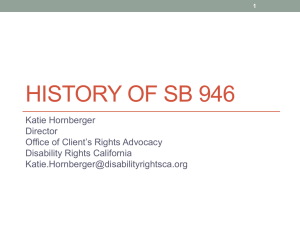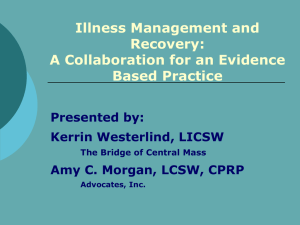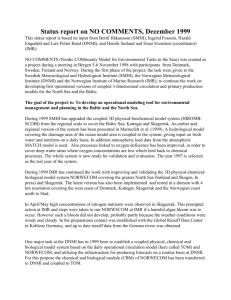Integration of Illness Management and Recovery within Assertive
advertisement
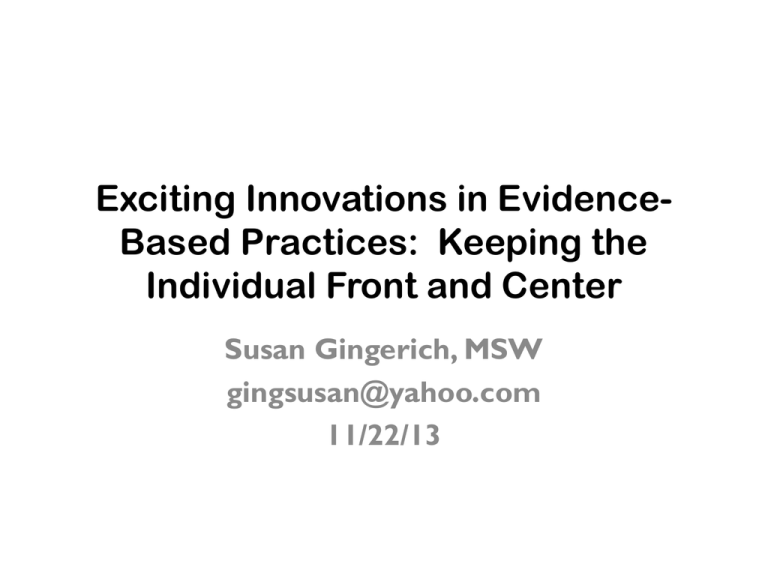
Exciting Innovations in EvidenceBased Practices: Keeping the Individual Front and Center Susan Gingerich, MSW gingsusan@yahoo.com 11/22/13 Short History: SAMHSA EvidenceBased Practices • Toolkit committees formed and began to meet in 2000 • Toolkits piloted beginning in 2002 • Goal = make EBPs user-friendly and available to a wide range of agencies and consumers • Goal=Help consumers move forward in recovery, improve their quality of life, and accomplish life goals Making SAMHSA Toolkits Available First editions, based on pilot, online 2005 – Assertive Community Treatment (ACT) – Integrated Dual Disorders Treatment (IDDT) – Family Education (FE) – Supported Employment (SE) – Illness Management and Recovery (IMR) Making EBP Toolkits Available In addition, Social Skills Training is an EBP, with structured manuals and curriculum, which has also been the source of innovations and improvements. How Evidence-based Practices Evolve Evidence: Research Client Factors Clinical Experience Evidence-Based Thinking Evidence Based Practices Revisions on Line 2008 • Based on additional feedback from pilot agencies and from wider community • Example of a few changes in IMR Module 6 (Drug and Alcohol Use) added Group guidelines & handouts provided Modules divided into sessions Module 9 (coping w/ symptoms ) revised & expanded Examples of 2011 IMR improvements • More time on identifying personally meaningful goals & breaking into steps • Goal-tracking sheet to be used throughout • Systemic review of goals in individual & group sessions • Expansion of Practical Facts, Building Social Support, Coping with Symptoms • New Module: Healthy Lifestyles Improvements in IMR, cont’d • “Check-it-outs” to give more practice of strategies and skills • IMR scales (client and clinician version) • Home practice sheets (Part A = use something from session, and Part B = take step towards your goal) • Flexibility in order of modules and delivering “targeted” skills Overall Themes of Innovations and Improvements to EBP’s 1. Increased emphasis on personal goals 2. Increased use of CBT and skills training 3. Multiple translations and cultural adaptations 4. Combinations of EBPs for multiple challenges 5. Novel methods of delivery (including technology) 6. New research on developing interventions to address special needs of individuals 1. Increased Emphasis on Personal Goals • • • • • • Assertive Community Treatment (ACT) Integrated Dual Disorders Treatment (IDDT) Family Education (FE) Supported Employment (SE) Illness Management and Recovery (IMR) Social Skills Training (SST) ACT --Remains extremely important to help people stay well and out of hospital --Also important to explore “Why?” • “What would you be able to do if your life wasn’t interrupted by hospitalizations?” • “How would you like to be spending your time?” • “Who would you like to be spending your time with?” • Essentially: How can we help you make your life like you would want it to be? IDDT • Remains important to help people with dual disorders decrease or stop use • Also important to explore “Why?” • “What would your life be like if you weren’t drinking or using drugs?” • “What would you be able to do? Who would you be able to spend time with?” • “How can we help you start on some of those changes now?” Family Education and Support • Remains important to involve whole family in support of treatment. • Also imp to explore “why” with individual • “What would you like your family to understand better about your experience?” • “How might your life be better if you had understanding & support from family?” • “How could family help you w/ goals?” • “How could you help your family?” Family Education, cont’d • Explore more of the “why” with family members • “What would you like to understand better about your relative’s experience?” • “What are your relative’s personal goals?” • “How could family help w/ their goals?” • “How could your relative help you with your goals?” Example of innovation for increasing family involvement “Outcomes of a Brief Program, REORDER, to Promote Consumer Recovery and Family Involvement in Care” by Lisa Dixon, Shirley Glynn, et al. Psychiatric Services , Nov 2013. Supported Employment --Still important to help person get a job or go to school --Important to remember that the “why?” of a job or school varies for each individual • income and standing in the community • way to introduce self to new people and potential friends and romantic partners • way of being around people and decreasing loneliness • Keeping up with friends and/or family members IMR --Learning illness management strategies and skills remains vital. --The “why” is different for each individual and for each module, depending on person’s goal • More time is spent on module 1 (Definition of Recovery and recovery goals) • Development of Goal-tracking sheet • Consistent review of personal goals • Practice, role play, home assignments geared towards goals IMR, cont’d • Tailoring the modules to the clients, not vice versa. • Question, How could same module, “Coping with Stress,” be helpful to people with following goals? Getting a job Taking an art class Spending more time with my children Moving to my own apartment Social Skills Training • Important to help people develop social skills, but not in a vacuum. • The reasons people want or need social skills varies based on their goals. • Examples of changes to SST model used by VA Meeting individually to establish personal goals Tailoring role plays around goals Developing home practice assignments based on taking steps towards personal goals 2. Increased Use of CBT and Active Skills Training Once people have identified goals, what next? Develop skills to overcome challenges. Examples: • ACT: Coping skills for persistent symptoms. • IDDT: Skills for attending meetings • FE: Skills for responding to Early Warning Sign • SE: On-line job search, group interviews Examples of Increased Use of CBT Skills Training, cont’d • • IMR Skills for Sharing your relapse prevention plan with others Practicing elements of your relapse prevention plan to increase preparedness Learning positive self-talk for specific voices SST Applying skill to personal goal 3 role plays per person each session Home practice tailored: Who do you want to give a compliment to? What compliment? When? Where? 3. Multiple Translations and Cultural Adaptations Example: IMR translated into Arabic Laotian Chinese Norwegian Danish Somali Dutch Spanish (Mexican) Hebrew Spanish (Puerto Rican) Hmong Swedish Japanese In progress: French, Russian, Malay Cultural Adaptations Adaptations in process of IMR for “Cultures within Cultures” • Geriatrics • Intellectually disabled • Persons with co-occurring physical health problems • Forensics • Homeless • Deaf community 4. Combination of EBPs for Multiple Challenges Examples • Cognitive Remediation + IMR + Supported Employment (Brooklyn Bureau) • ACT+ IMR (University of Washington and Places for People, St. Louis) • IMR + Co-occurring Disorders (University of Minnesota) 5. Novel Methods of Delivery High Tech • Computers (Cognitive Behavioral Therapy for Voices and Paranoia, Jen Gottlieb, Boston University) • Smart Phones (App with 5 targets developed by Dror Ben-Zeev, Dartmouth University) • I-Pad (Rickard Fardig, Piper Meyer, Kim Mueser) • PPT slides (Eddy Suarez at Sunrise Community Mental Health Center, Everett, Washington) Novel Methods, cont’d Low tech • Tanzanian model of IMR with whole family attending, tea and lunch served, traditional handclapping and singing included • Japanese model of Relapse Prevention Training for inpatients, with family attending on the unit 6. Developing new interventions Examples: • RAISE (Recovery After an Initial Schizophrenia Episode) • Health Technology Program (for individuals who have recently experienced a hospitalization) RAISE 17 sites piloted the Navigate Program (including St. Clare’s in NJ). Provides: • Individualized medication management (Compass) • Individual Resiliency Training (IRT) • Supported Employment and Education (SEE) • Family Education Program (FEP) Health Technology Program 9 sites piloting a Relapse Prevention Planning (RPP) program that includes technology tools • Core = 5 in-person RPP sessions • FOCUS app for Smart Phone (targets = mood, voices, medications, socialization, sleep) • Daily Support Website for families and clients • Computer CBT for Voice and for Paranoia In HTP clients are already using tech tools in creative ways • Using smart phones to help remind selves of appointments and leisure activities, keep lists of steps towards goals, take photos of relapse prevention plan, get in touch with people to prevent isolation • Using computer to search for jobs, e-mail friends or family, locate activities in their community, take on-line courses, download budget templates, check hours of DMV What can we take away from these innovations? Look at the practices you are offering. Ask yourselves these questions: 1. How are personal goals addressed in the practice? Could this be strengthened? 2. What specific skills are being taught in the practice to help people address their goals? 3. How are cultural differences addressed in the practice? What translations might be helpful? Take away, cont’d 4. Would it be beneficial to offer additional practices (E.g., social skills training for clients whose goals center around relationships) or combined practices? 5. Would additional delivery systems be helpful to your clients? E.g., posting educational materials on-line? Using ppts? 6. Is your agency interested in learning more about first episode Tx? About technologies? Final comments Let’s hear from clients themselves in this DVD showing a graduation from IMR in St. Louis.
